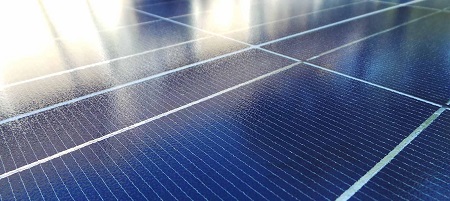The use of solar energy in the U.S. is growing, but panels on rooftops are still a rare sight. They cost thousands of dollars, and homeowners don’t recoup costs for years even in the sunniest or best-subsidized locales. But scientists may have a solution.
They report the development of a unique, “green” antenna that could potentially double the efficiencies of certain kinds of solar cells and make them more affordable.
The researchers are presenting their work at the 250th National Meeting & Exposition of the American Chemical Society (ACS). ACS, the world’s largest scientific society, is holding the meeting here through Thursday. It features more than 9,000 presentations on a wide range of science topics.
“Most of the light from the sun is emitted over a very broad window of wavelengths,” says Challa V. Kumar, Ph.D. “If you want to use solar energy to produce electric current, you want to harvest as much of that spectrum as possible.”
But the silicon solar cells people buy today are not very efficient in the blue part of the light spectrum. So Kumar’s team at the University of Connecticut built an antenna that collects those unused blue photons and then converts them to lower energy photons that the silicon can then turn into current.
“Many groups around the world are working hard to make this kind of antenna, and ours is the first of its kind in the whole world,” he says.
Commercial solar cells do a good job of converting light from about 600 to 1,000 nanometers (nm) into electric current but not from the 350 to 600 nm range. That’s part of the reason solar cells on the market today are only about 11 to 15 percent efficient. High-end panels can reach 25 percent efficiency but are unaffordable for most customers. Lab prototypes can reach even higher efficiencies but are difficult to scale up.
Converting the mostly unused portion of the light spectrum to wavelengths solar cells can use in an affordable way is far from a simple task. To tackle this problem, Kumar turned to organic dyes. Photons in light excite dye molecules, which can then, under the right circumstances, relax and emit less energetic but more silicon-friendly photons.
But to get dye molecules to work together, they need to be wrapped individually and densely, while satisfying certain quantum mechanical requirements. To address this issue, they embed the dyes inside a protein-lipid hydrogel by mixing them together, warming them up and then cooling them to room temperature. With this simple process, the material wraps around individual dye molecules, keeping them separated while packing them densely. Rather than creating a radio-like antenna, however, the procedure results in a thin, pinkish film that can be coated on top of a solar cell.
“It’s very simple chemistry,” Kumar says. “It can be done in the kitchen or in a remote village. That makes it inexpensive to produce.”
These antennas are made with biological and non-toxic materials that are edible in theory, Kumar says. “Not that you would want to eat your solar cells, but they should be compostable so they won’t accumulate in the environment,” he says.
Now his team is working with a Connecticut company to figure out how to apply the artificial antenna to commercial solar cells. In other projects, they also are figuring out ways to use the versatile hydrogel for drug delivery and white light-emitting diodes.
Kumar acknowledges funding from the University of Connecticut and the National Science Foundation.
The American Chemical Society is a nonprofit organization chartered by the U.S. Congress. With more than 158,000 members, ACS is the world’s largest scientific society and a global leader in providing access to chemistry-related research through its multiple databases, peer-reviewed journals and scientific conferences. Its main offices are in Washington, D.C., and Columbus, Ohio.
Reference(s):
Story: Solar cell efficiency could double with novel ‘green’ antenna | American Chemical Society — August 18, 2015












Comments